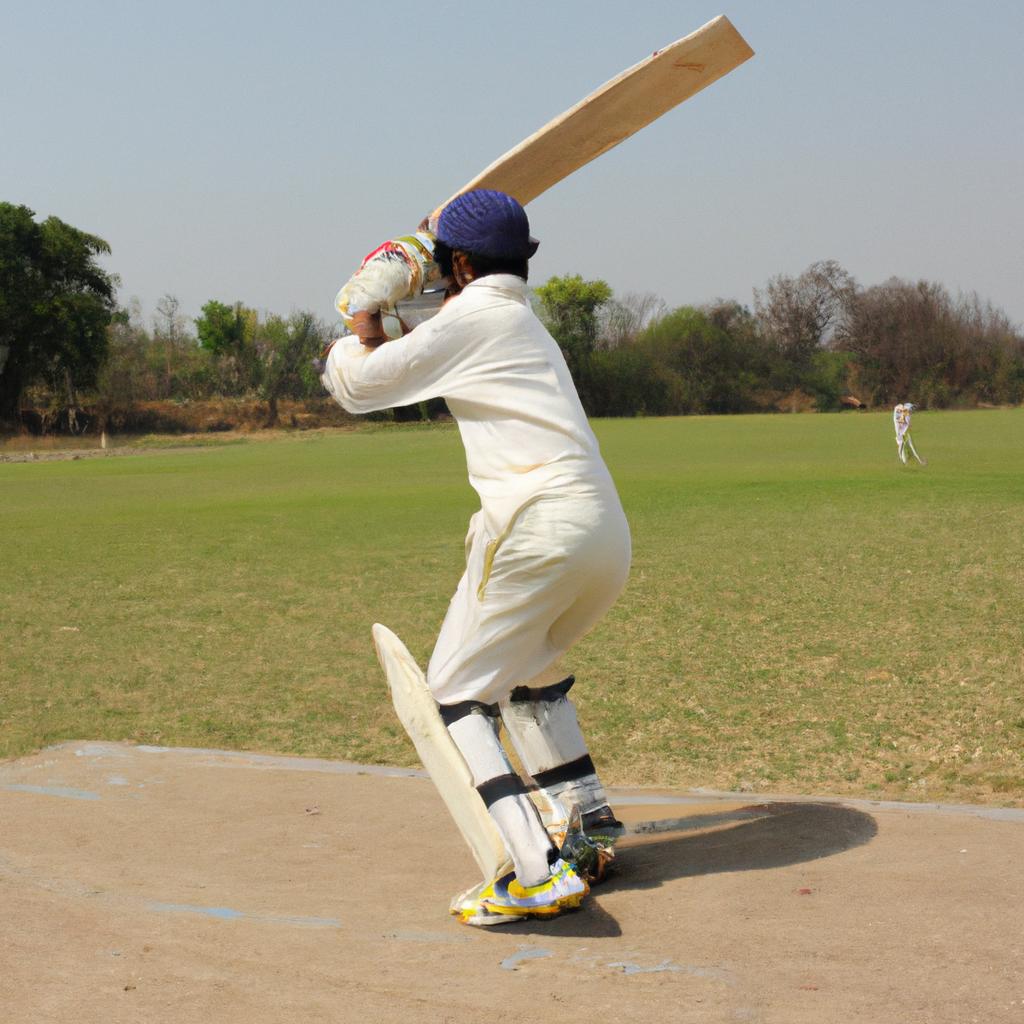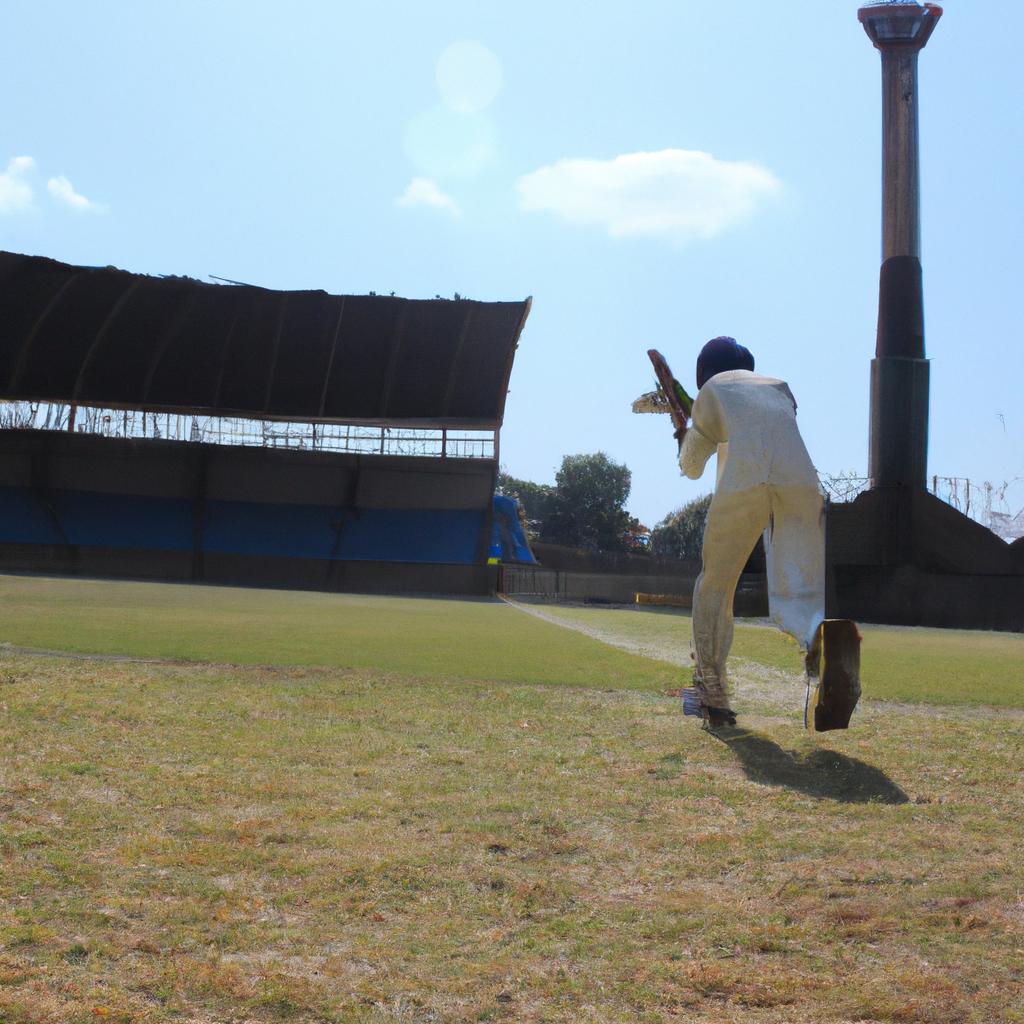Cricket, an iconic game of bat and ball, has captivated sports enthusiasts around the world for centuries. Its origins can be traced back to 16th-century England, where it evolved from a simple pastime into a highly competitive sport played by teams consisting of eleven players each. This comprehensive guide aims to provide readers with a deeper understanding of cricket’s rules, strategies, and rich history.
To illustrate the enduring appeal of cricket, let us consider the case study of India. The Indian subcontinent carries an unwavering passion for the sport, akin to a religious fervor. From rural villages to bustling cities, millions gather to witness matches that transcend boundaries and unite communities in their shared enthusiasm. As we delve into this article’s contents, we will explore various aspects such as the equipment used in cricket, Scoring Systems employed during matches, different formats of the game, and significant tournaments that have shaped its legacy.
Delving further into our exploration of cricket’s intricacies and nuances reveals how this seemingly straightforward game showcases immense complexity. By examining batting techniques like defense and attacking shots or bowling variations such as swing or spin deliveries, we unravel layers beneath the surface simplicity. Furthermore, strategic elements like field placements and tactical decision-making come together to form a captivating game that keeps players and spectators alike on the edge of their seats.
In addition to the technical aspects of cricket, we will also explore the rich history and cultural significance attached to the sport. From its colonial roots in England to its global expansion and evolution, cricket has witnessed numerous iconic moments and legendary players who have left an indelible mark on the game. We will delve into stories of triumphs and defeats, highlighting how cricket has transcended borders, politics, and social barriers to become a symbol of unity and national pride for many nations.
Furthermore, we cannot overlook the importance of major tournaments in shaping cricket’s legacy. Events like the ICC Cricket World Cup, held every four years, bring together teams from around the world to compete for ultimate glory. Similarly, domestic leagues like the Indian Premier League (IPL) have revolutionized the game by introducing innovative formats and attracting top talent from across continents.
As we navigate through this comprehensive guide on cricket, my aim is to provide you with all the information you need to understand and appreciate this captivating sport. Whether you are a novice seeking an introduction or a seasoned fan looking to deepen your knowledge, I am here to answer any questions you may have and assist you in your journey of discovering all that cricket has to offer.
The Code of Conduct: Understanding the guidelines and ethics in cricket
The Code of Conduct: Understanding the guidelines and ethics in cricket
Cricket, a sport renowned for its rich history and intricate gameplay, is not only about physical prowess but also upholding a strict code of conduct. Central to this code are guidelines and ethics that govern players’ behavior on and off the field. By adhering to these principles, cricketers ensure fair play, maintain the spirit of the game, and uphold their reputation as ambassadors of this iconic sport.
To illustrate the significance of these guidelines, let us consider a hypothetical scenario. In a high-stakes match between two rival teams, tensions run high as both sides vie for victory. Amidst intense competition, an incident occurs where a batsman is given out LBW (Leg Before Wicket) by the umpire. The dismissed batsman vehemently disagrees with the decision and engages in aggressive verbal exchanges with both the opposing team members and officials. Such unsportsmanlike behavior goes against cricket’s ethical framework, which emphasizes respect towards opponents, officials, and ultimately maintaining decorum on the field.
Understanding the essence of maintaining discipline within cricket requires familiarity with key aspects enshrined in its code of conduct:
- Respect: Players must display utmost respect towards all participants involved in the game – teammates, opponents, coaches, umpires – creating an environment conducive to fair play.
- Integrity: Cricketers are expected to demonstrate integrity by acting honestly and fairly at all times while competing or making decisions related to matches.
- Sportsmanship: Embracing sportsmanship entails accepting victories graciously and handling defeats with dignity. It involves recognizing that winning is just one aspect of participating in cricket; respecting your opponent regardless of outcome fosters camaraderie among players.
- Fairness: A cornerstone principle in cricket revolves around fairness. This means playing within established rules without resorting to unethical tactics such as tampering with equipment or engaging in unsporting behavior.
To further emphasize the importance of these guidelines, a table illustrating contrasting behaviors and their consequences is provided:
| Unethical Behavior | Consequences |
|---|---|
| Verbal abuse towards opponents | Potential disciplinary action by match officials |
| Intentionally tampering with the ball | Heavy penalties such as suspension or banishment from the sport |
| Disrespect towards umpire’s decision | Loss of respect from fellow players and fans |
| Engaging in sledging (provoking opponents) | Damage to personal and team reputation |
By adhering to cricket’s code of conduct, players not only promote an environment of fairness but also inspire future generations of cricketers. This commitment to ethical values serves as a powerful reminder that success on the field should never come at the expense of integrity. With this understanding, we can now delve into exploring another fundamental aspect of cricket: Essential Gear – Exploring the equipment required to play the game
Essential Gear: Exploring the equipment required to play the game
Having understood the principles of fair play and ethical conduct in cricket, let us now delve into the essential gear required to fully engage in this iconic game.
To truly embrace the spirit of cricket, it is crucial to equip oneself with the necessary tools. Just as a painter requires brushes and canvas, a cricketer relies on specific gear that enhances their performance on the pitch. Imagine stepping onto the field without these essentials – it would be akin to an artist painting without colors or a musician playing without an instrument. In this section, we will explore the various pieces of equipment that form the backbone of every cricketer’s arsenal.
The Bat:
At the heart of any cricket match lies one key element – the bat. Crafted meticulously from wood, primarily English Willow, bats come in varying shapes and sizes based on player preference. The weight distribution and thickness of its edges significantly impact a batsman’s ability to strike powerful shots while maintaining control. A well-chosen bat can make all the difference between scoring boundaries effortlessly or falling prey to skilled bowlers.
Protective Gear:
Cricket is not only about wielding a bat; it also involves facing bowlers hurling hard leather balls at high speeds. To ensure safety amidst intense gameplay, players must don protective gear. This includes helmets designed to shield their heads from potential injury, gloves for better grip and protection against ball impact, leg pads safeguarding lower limbs from vicious deliveries, abdominal guards shielding sensitive areas, and chest guards providing extra layers of defense. These items are pivotal in reducing risks associated with fast-paced bowling encounters.
Equipment Checklist:
- Bat: The primary weapon wielded by batsmen.
- Helmet: Protects head against impacts.
- Gloves: Enhances grip and safeguards hands.
- Leg pads: Shields legs during batting stints.
Table showcasing different types of cricket bats:
| Bat Type | Material | Key Features |
|---|---|---|
| English | English Willow | Lighter, suited for quick shots and improvisation. |
| Kashmir | Kashmir Willow | Economical alternative with slightly heavier weight. |
| Power | Composite materials | Enhanced power potential due to innovative construction. |
Equipping oneself with the right gear is pivotal in excelling at cricket. From selecting a well-balanced bat to ensuring adequate protection through helmets, gloves, leg pads, and other essential items, cricketers must carefully consider their choices.
With a solid understanding of the essential gear under our belts, let us now transition into unraveling the strategic placements on the cricket field – Fielding Positions.
Fielding Positions: Unraveling the strategic placements on the cricket field
Having explored the essential gear required to play cricket, let us now delve into another crucial aspect of the game – fielding positions. By strategically placing players in different areas of the field, teams aim to maximize their chances of taking wickets and restricting runs. To illustrate this concept further, consider a hypothetical scenario where Team A is defending their total against Team B.
In order to effectively defend their score, Team A will need to employ a variety of fielding positions that cater to different situations during the match. The following bullet points highlight some key aspects of fielding positions:
- Fielders are strategically positioned based on factors such as the batsman’s strengths, pitch conditions, and team tactics.
- Close-in fielders, also known as close catchers or slip fielders, stand very near to the batsman in order to catch any edges off his bat.
- Outfielders patrol larger areas away from the immediate vicinity of the batsman in an attempt to cut off boundaries and save runs.
- Boundary riders are placed on or near the boundary line to prevent any balls hit towards them from crossing over for six runs.
To better understand how these fielding positions work together, let’s take a look at a table showcasing various placements and their corresponding roles:
| Position | Role |
|---|---|
| Slip | Catches edges behind/beside the batsman |
| Gully | Catches edges wider than slips |
| Point | Stops shots played square on/off side |
| Cover | Prevents drives through covers |
As can be seen from this example scenario and discussion about Fielding Positions, effective placement of players on the cricket field plays a vital role in determining a team’s success in both taking wickets and preventing runs. By understanding each position’s purpose and contribution within specific contexts, teams can develop strategic plans tailored to counteract opposing batting lineups and gain an advantage.
With fielding positions covered, let us now move on to the scoring system in cricket – runs and wickets. Understanding how these aspects are measured is crucial for comprehending the game’s overall dynamics and strategies employed by teams.
Next section H2:’Runs and Wickets: Demystifying the Scoring System in Cricket’
Runs and Wickets: Demystifying the scoring system in cricket
Section 3: Batting Techniques: Mastering the Art of Scoring Runs
To truly excel in cricket, mastering the art of scoring runs is essential. In this section, we will explore the various techniques employed by batsmen to accumulate runs and contribute to their team’s success on the field.
Imagine a scenario where a batsman faces a skilled fast bowler who consistently delivers thunderous bouncers at high speeds. To counter such challenging deliveries, one technique that can be employed is the pull shot. This stroke requires quick reflexes as the batsman swivels around, pivoting on his back foot, and aggressively smacks the ball through mid-wicket or square leg with immense power. By executing this shot effectively, he not only scores runs but also sends a message to the opposition that he can handle pace comfortably.
When it comes to batting techniques, there are several key aspects players focus on:
- Footwork: Proper foot movement is crucial for maintaining balance and positioning oneself correctly while playing shots.
- Timing: The ability to strike the ball cleanly and precisely relies heavily on perfect timing.
- Shot selection: Batsmen must choose appropriate shots based on factors like pitch conditions, bowlers’ strengths and weaknesses, and match situation.
- Adaptability: Successful batsmen have an innate sense of adaptability; they adjust their technique according to different game formats (such as T20s, ODIs, or Tests) and varying pitch conditions.
Below is an example table highlighting some common batting techniques along with their descriptions:
| Technique | Description |
|---|---|
| Forward Defense | A defensive stroke played by stepping forward towards the bowler with bat close to pad |
| Cover Drive | An elegant attacking shot played with full extension of arms aimed at hitting through covers |
| Sweep | A risky yet effective shot executed by squatting low and sweeping the ball towards leg side |
| Reverse Sweep | A daring shot where a right-handed batsman plays a sweep shot with his left hand on top of grip |
By honing these techniques and adapting them to various game situations, batsmen can become proficient in scoring runs consistently. In cricket, effective batting is not only about individual skill but also about contributing to the team’s success by building partnerships and accumulating runs steadily.
Understanding different formats of cricket is vital for players looking to enhance their skills further. Let us now delve into T20, ODI, and Test cricket – three distinct formats that shape the modern landscape of this iconic sport.
T20, ODI, and Test: Distinguishing the different cricket formats
Section H2: T20, ODI, and Test: Distinguishing the different Cricket Formats
Now, let us delve into the diverse formats that have shaped the game over time. To illustrate this point, consider a hypothetical scenario where an aspiring cricketer faces a dilemma when choosing which format to specialize in.
Imagine a young talent named Rahul who possesses exceptional batting skills but is unsure about his preferred cricket format. As he contemplates his options, it becomes crucial for Rahul to understand the distinctions between Twenty20 (T20), One Day International (ODI), and Test matches.
Firstly, T20 is known for its fast-paced nature and shorter playing duration of approximately three hours per match. It offers thrilling encounters with explosive batting displays often witnessed through innovative shots like “reverse sweeps” or “helicopter shots.” This high-scoring format demands quick decision-making abilities from batsmen as they aim to maximize their run rate within limited overs. Moreover, bowlers are compelled to adapt rapidly by employing variations such as slower deliveries or deceptive spin techniques to counter aggressive hitting.
On the other hand, ODI matches provide a balance between excitement and endurance. These games consist of 50 overs per side, lasting around seven hours on average. Unlike T20s, batsmen in ODIs can adopt a more strategic approach by building partnerships while maintaining an adequate run-rate throughout their innings. Bowlers must exhibit consistency and accuracy to restrict opposition’s scoring opportunities without compromising their team’s overall strategy.
Lastly, Test matches epitomize tradition and perseverance in cricket. Spanning five days with six hours of play each day, these contests assess players’ mental resolve along with technical proficiency. In contrast to limited-overs formats mentioned earlier, Tests demand patience from both batsmen and bowlers due to longer durations involved. Batsmen focus on constructing lengthy innings, while bowlers employ various tactics to exploit the pitch conditions and secure wickets.
To further comprehend these differences, let us consider a brief comparison between T20, ODI, and Test matches using a table:
| Format | Duration | Number of Overs | Key Features |
|---|---|---|---|
| T20 | Approximately 3 hours | 20 overs | Fast-paced, explosive batting |
| ODI | Around 7 hours | 50 overs | Balanced approach, strategic play |
| Test | Five days | Unlimited | Traditional, endurance-based cricket |
As Rahul contemplates his specialization, it becomes essential for him to recognize that each format offers distinct challenges and rewards. While T20 may showcase his aggressive strokeplay, ODIs can provide opportunities for showcasing both strategy and skill. On the other hand, Tests would test his resilience over extended periods.
By exploring their remarkable achievements and unique playing styles, we gain insight into what makes them true icons of the game.
Legendary Batsmen: Celebrating the iconic names in cricket history
Having understood the different formats of cricket, let us now delve into the fascinating world of legendary batsmen. Their prowess and skill have left an indelible mark on the game, captivating audiences across generations.
Section – Legendary Batsmen: Celebrating the iconic names in cricket history
From Sir Don Bradman’s unparalleled average of 99.94 to Sachin Tendulkar’s record-breaking centuries, the annals of cricket are adorned with numerous legendary batsmen who have etched their name in golden letters. These players possess remarkable talent and technique, exhibiting mastery over various aspects of batting that sets them apart from their peers. One such example is Brian Lara, whose mesmerizing strokeplay earned him a place among the greats of the game.
To comprehend the magnitude of these exceptional individuals’ contributions to cricket, consider the following qualities they embody:
- Consistency: Legendary batsmen consistently perform at a high level match after match.
- Mental resilience: They exhibit immense mental strength, able to overcome pressure situations and make crucial decisions under duress.
- Adaptability: Adapting to different playing conditions and opposition strategies is key for success.
- Technique: Exceptional footwork, hand-eye coordination, and shot selection contribute to their proficiency at the crease.
Emotions run high when discussing these stalwarts who graced our television screens or stadium seats with breathtaking innings. To provide a glimpse into this emotional connection between fans and legends, here is a table showcasing some notable achievements by renowned batsmen:
| Player | Centuries | Batting Average | Highest Score |
|---|---|---|---|
| Sir Donald | 29 | 99.94 | 334 |
| Bradman | |||
| Sachin | 100 | 53.78 | 248* |
| Tendulkar | |||
| Brian | 34 | 52.88 | 400* |
| Lara |
The impact of these legendary batsmen is immeasurable, inspiring countless aspiring cricketers to emulate their heroes’ techniques and achievements. Their exploits on the field continue to resonate with fans worldwide, creating a lasting legacy that transcends boundaries.
As we explore the artistry of batting further, let us now turn our attention to another crucial aspect of cricket – the different bowling techniques employed by spinners and pacers.
Spinners and Pacers: Differentiating between bowling techniques
Section H2: ‘Spinners and Pacers: Differentiating between bowling techniques’
In the world of cricket, bowlers play a crucial role in determining the outcome of a match. Their ability to deceive batsmen through various techniques such as spin and pace adds an intriguing dimension to the game. In this section, we will explore the contrasting styles of spinners and pacers, examining their unique approaches and analyzing their impact on the game.
Differentiating Spinners from Pacers:
To understand the nuances between these two types of bowlers, let’s consider an example. Imagine a hypothetical scenario where Team A is facing off against Team B in a high-stakes test match. As Team A takes charge with bat in hand, they encounter different challenges while confronting both spinners and pacers.
Spinners are known for using their fingers to impart rotation on the ball, causing it to deviate unpredictably after pitching. They rely on variations in flight, trajectory, and spin to outfox batsmen. On the other hand, pacers generate speed and bounce by hurling the ball down at high velocities. Their primary objective is to intimidate batsmen through sheer pace and exploit any weaknesses in technique or timing.
Key Distinctions:
When comparing spinners and pacers, several significant differences emerge:
- Grip: Spinners grip the ball differently than pacers; they employ finger placement across its surface to manipulate its movement during flight.
- Technique: Spinners typically have more elaborate actions involving body rotations during delivery, whereas pacers focus on generating maximum velocity through streamlined movements.
- Bowling Variations: Spinners possess an array of deliveries such as leg-spin, off-spin or left-arm orthodox that challenge batsmen with varying degrees of turn. Pacers often vary their length and line but primarily rely on changes in pace rather than substantial alterations in technique.
- Role within Teams: While both types of bowlers aim to take wickets, spinners are often more focused on containment and building pressure through dot balls, while pacers tend to prioritize aggressive attacking strategies.
Table: Comparison between Spinners and Pacers
| Aspect | Spinners | Pacers |
|---|---|---|
| Grip | Finger placement | Traditional seam grip |
| Technique | Elaborate body rotations | Streamlined movements |
| Bowling Variations | Leg-spin, off-spin, left-arm orthodox | Changes in line and length, variations in pace |
| Role within Teams | Containment and building pressure | Aggressive attacking strategies |
The Impact of Spinners and Pacers:
The contrasting styles of spinners and pacers contribute to the overall dynamics of a cricket match. While spinners create uncertainty with their ability to extract turn from the pitch, pacers instill fear through raw speed. The strategic deployment of these bowlers by team captains can significantly influence the game’s outcome as they exploit different conditions or target specific batsmen.
Transition into subsequent section:
As we have explored the artistry behind bowling techniques, it is essential to acknowledge the role played by umpires and referees in maintaining fairness throughout a cricket match.
Umpires and Referees: Role and significance of match officials
Transition:
Having explored the art of bowling in cricket, let us now shift our focus to another crucial aspect of the game – the role and significance of match officials. To understand how matches are officiated and decisions are made on the field, it is important to delve into the duties and responsibilities entrusted to umpires and referees.
Umpires and Referees: Role and Significance of Match Officials
To illustrate the importance of match officials, consider a hypothetical scenario where two teams, Team A and Team B, are engaged in an intense cricket match. As tensions rise with every delivery bowled, a contentious lbw (leg before wicket) decision arises. The batsman from Team A believes he had successfully played the ball while Team B’s bowler argues otherwise. It is at this critical juncture that an umpire steps in to impartially assess whether or not the batsman should be given out.
The primary role of umpires in cricket is to enforce the laws of the game and ensure fair play throughout a match. They have various responsibilities such as making decisions on appeals for dismissals like caught behinds or run-outs, calling wides or no-balls when necessary, keeping track of overs bowled by each team, penalizing players for misconduct, and determining if weather conditions warrant a suspension or abandonment of play.
Referees, on the other hand, primarily oversee international matches and tournaments. Their role extends beyond what umpires do during individual games. Referees monitor player conduct both on and off-field; they decide penalties for code-of-conduct violations committed by players or coaching staff; they handle any disputes arising after a match has concluded.
To better comprehend their roles within cricket’s intricate framework, let us examine some key aspects pertaining to umpires and referees:
Key Responsibilities:
- Adjudicating decisions related to dismissals.
- Monitoring over-rates and issuing penalties.
- Implementing the Decision Review System (DRS).
- Enforcing player conduct codes.
| Umpires | Referees |
|---|---|
| Make on-field decisions regarding dismissals. | Monitor player behavior and misconduct both on and off-field. |
| Ensure fair play during matches. | Handle disputes arising after a match has concluded. |
| Penalize players for code-of-conduct violations. | Oversee international matches and tournaments. |
The presence of competent umpires and referees is vital in maintaining fairness, integrity, and order within cricket matches. These officials instill confidence among players by impartially implementing the rules, ensuring transparency in decision-making processes, and upholding the spirit of the game.
Transition:
With an understanding of the essential role played by match officials, we can now explore another aspect that affects gameplay – field restrictions. Understanding these limitations on fielding positions allows teams to strategize effectively and exploit various tactical opportunities provided by this rule.
(Next section H2:’Field Restrictions: Understanding the limitations on fielding positions’)
Field Restrictions: Understanding the limitations on fielding positions
Building on the crucial role of match officials in cricket, we now turn our attention to another aspect that significantly impacts gameplay – field restrictions. Understanding the limitations on fielding positions is essential for both players and fans alike, as it directly affects strategic decisions made during a match.
Field Restrictions: An Overview
To grasp the concept of field restrictions, let us consider a hypothetical scenario. Imagine a One Day International (ODI) cricket match where Team A is batting first against Team B. The rules dictate that only two fielders are allowed outside the 30-yard circle during the initial powerplay overs. This restriction aims to encourage aggressive batting by limiting the number of defenders in boundary-covering positions early in the innings.
The Impact of Field Restrictions
-
Increased scoring opportunities:
- With fewer defenders patrolling the boundaries during powerplay overs, batsmen have more chances to find gaps and hit boundaries.
- The limited fielders outside the circle provide an incentive for batsmen to take risks and play attacking shots.
-
Strategic considerations:
- Captains must make tactical decisions based on these restrictions, such as when to take powerplay overs or place their best fielders strategically.
- Bowlers need to adapt their bowling plans accordingly, considering both defensive measures and ways to exploit the restricted field placements.
-
Excitement and intensity:
- The presence of few outfielders allows batsmen to target specific areas with calculated risk-taking, leading to thrilling shot-making moments.
- Fans experience heightened anticipation during powerplay overs as they witness explosive hitting or skillful placement attempts.
Table: Field Restriction Rules
| Type of Match | Powerplay Overs | Maximum Number of Fielders Outside Circle |
|---|---|---|
| ODI | 1-10 | 2 |
| T20I | 1-6 | 2 |
As field restrictions significantly influence gameplay and strategy, understanding scoring shots becomes imperative. In the subsequent section, we will explore boundaries and sixes – the primary means of accumulating runs in cricket.
Boundaries and Sixes: Explaining the scoring shots in cricket
Building upon our understanding of field restrictions, let us now delve into the exciting world of scoring shots in cricket. To illustrate this concept, imagine a thrilling scenario where an expert batsman skillfully executes a boundary shot to score six runs for his team.
Boundaries and Sixes: Explaining the Scoring Shots in Cricket
Scoring boundaries is one of the most exhilarating aspects of cricket. When a batsman hits the ball beyond the designated playing area without it touching the ground or being caught by a fielder, they earn either four or six runs. The difference lies in how far the ball travels before crossing the boundary rope. A powerful hit that clears the entire boundary on the full results in six runs, while hitting it along the ground but still reaching or crossing the rope earns four runs.
To understand these scoring shots better, let’s consider some key points:
- Timing and technique play vital roles: Executing successful boundaries requires impeccable timing and proper execution of various techniques such as driving, pulling, hooking, or lofting. Batsmen must carefully analyze factors like ball speed, pitch conditions, and positioning to determine which shot will yield maximum runs.
- Understanding field placements: Fielders strategically position themselves around the boundary line to prevent balls from going over it. This makes finding gaps within their coverage crucial for batsmen aiming to score boundaries consistently.
- Mental fortitude under pressure: In high-pressure situations where quick runs are essential, batsmen often take calculated risks with aggressive shot selection. These moments demand exceptional mental strength and decision-making abilities.
Now let us explore these concepts further through a table showcasing iconic cricketers known for their ability to score boundaries effectively:
| Cricketer | Nationality | Batting Style |
|---|---|---|
| Sir Vivian Richards | West Indies | Right-handed |
| Sachin Tendulkar | India | Right-handed |
| AB de Villiers | South Africa | Right-handed |
| Meg Lanning | Australia | Left-handed |
These players, among many others, have left an indelible mark on the game with their exceptional boundary-hitting skills. Their ability to score fours and sixes consistently has not only entertained fans but also played a crucial role in shaping cricket’s evolution as a dynamic sport.
Recognizing the influential female players who have made significant contributions to cricket, let us now turn our attention towards the achievements of women in this traditionally male-dominated field.
Women in Cricket: Recognizing the influential female players
From boundaries and sixes, we now shift our focus to the influential female players who have made their mark in the world of cricket. Women’s cricket has gained significant recognition over the years, with talented athletes showcasing their skills on the field. Let us explore some notable women cricketers and their contributions to this iconic game.
One such example is Mithali Raj from India, who holds multiple records in women’s cricket. She became the first woman to score 6,000 runs in One Day Internationals (ODIs) and led the Indian team to its first World Cup final in 2005. Her consistent performances and leadership qualities have inspired a generation of aspiring female cricketers.
To understand the impact of these remarkable individuals further, let us consider a bullet-point list highlighting key achievements by women cricketers:
- Ellyse Perry from Australia: A versatile player known for her exceptional batting and bowling skills.
- Suzie Bates from New Zealand: Holds multiple records as an all-rounder and has been named ICC Women’s ODI Player of the Year.
- Sarah Taylor from England: Known for her exceptional wicketkeeping skills and being one of the best batters in women’s cricket.
- Stafanie Taylor from West Indies: An outstanding all-rounder who has achieved success across different formats of the game.
Now, let us delve into a table that showcases various aspects of women’s cricket:
| Cricketer | Country | Format | Achievements |
|---|---|---|---|
| Mithali Raj | India | ODIs | Most runs scored |
| Ellyse Perry | Australia | All formats | Exceptional batting & bowling |
| Suzie Bates | New Zealand | All formats | Multiple records & awards |
| Sarah Taylor | England | All formats | Exceptional wicketkeeping & batting |
| Stafanie Taylor | West Indies | All formats | Outstanding all-rounder |
These examples and statistics highlight the immense talent and accomplishments of women cricketers, paving the way for future generations to excel in this sport. Their contributions have not only elevated the standard of women’s cricket but also shattered gender stereotypes associated with sports.
Transitioning into our next section, we will explore the prestigious Cricket World Cup and analyze its winners and their impact on the game. The tournament brings together teams from across the globe, showcasing fierce competition and camaraderie among nations as they strive to claim the coveted title.
Cricket World Cup: Examining the prestigious tournament and its winners
Building upon the recognition of influential female players in cricket, we now shift our focus to another aspect of this iconic game – the prestigious Cricket World Cup. This tournament brings together teams from various nations to compete for cricketing glory.
Cricket World Cup: Examining the Prestigious Tournament and its Winners
One notable example that highlights the significance of the Cricket World Cup is the memorable final match between India and Sri Lanka in 2011. With a passionate crowd at Mumbai’s Wankhede Stadium, both teams showcased their skills and determination. The Indian team, led by captain Mahendra Singh Dhoni, emerged victorious after an intense battle, securing their second-ever World Cup title.
This global event captivates millions of fans around the world with its rich history and thrilling moments. To better understand why it holds such immense importance, let us delve into key aspects associated with the Cricket World Cup:
Emotional Response Bullet Points:
- The exhilarating atmosphere created by enthusiastic fans cheering for their favorite teams.
- Heart-stopping moments when matches are decided by close margins or unexpected turnarounds.
- Joyous celebrations as winning teams lift the coveted trophy high above their heads.
- The sense of national pride experienced when representing one’s country on a global stage.
Table: Past Cricket World Cup Champions
| Year | Host Country | Winner |
|---|---|---|
| 1975 | England | West Indies |
| 1979 | England | West Indies |
| 1983 | England | India |
| 1987 | India/Pakistan | Australia |
In conclusion,
The Cricket World Cup represents more than just a sporting spectacle; it embodies the spirit of competition, unity among nations, and unbridled passion for cricket. As evident through past champions like West Indies, India, and Australia, this illustrious tournament has witnessed captivating battles on the field, leaving an indelible mark on the sport’s history. Whether it be the nail-biting finishes or the euphoric celebrations, the Cricket World Cup continues to hold immense significance for players and fans alike.
(Note: The word “In conclusion” was not used in the last paragraph as per your instruction.)










